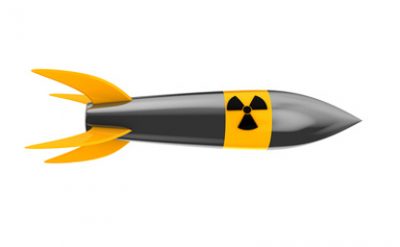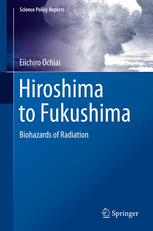From Hiroshima to Fukushima: Nuclear Weapons and the Dangers of Nuclear Radiation
We Need to Expand the Nuclear Weapon Ban Treaty (NWBT) to A Comprehensive Nuclear Ban Treaty (NBT)

First published by GR on October 16, 2017
Mankind discovered the nuclear world by its intellect; atom, nucleus, nucleon, elementary particle, and then some reactions at the nucleus level. A significant discovery was that there are stable nuclei as well as unstable ones, and that an unstable nucleus tends to change to a more stable condition, emitting the extra energy in the form of radiation. Another was nuclear fission and nuclear fusion reactions.
The discovery of nuclear fission immediately led the German government to explore the use of nuclear fission as the basis of powerful weapon. A few scientists including Einstein urged the US president to develop such a weapon before the Germans would succeed. The US government secretly established the “Manhattan project”, and the scientists and the corporations involved managed to make three pieces of such weapon, i.e., atomic bombs before the end of the World War II. One was used to test its effectiveness in New Mexico, and the remaining two were dropped on Hiroshima and Nagasaki. The results were devastating, killing hundreds of thousands instantly and flattening the entire cities.
Several countries, Soviet Unions (now Russia), UK, France and China, followed suit. They, as well as the USA, eagerly developed the nuclear programs and produced an enormous number of such weapons. Besides, they have made the weapons more powerful, incorporating the nuclear fusion reaction; i.e, the combination of hydrogen bomb (nuclear fusion) and the nuclear fission (atomic bomb). Such a weapon is now called as “thermonuclear weapon”, which seems to reduce the impression of the devastating effects it can cause. In fact, many of them are more than 100 times powerful compared with the Hiroshima bomb. A few other countries have now developed nuclear arsenals despite of the NPT (Non Proliferation Treaty): they are Israel, India, Pakistan and North Korea.
The dangers of using the nuclear arsenals are obvious, and yet it took more than half a century to establish the nuclear weapon ban treaty (NWBT). And a Nobel peace prize has been awarded to an international organization “ICAN”, which contributed to the NWBT. Yet, the danger of use of nuclear arsenals is now ever increasing. The creation of this weapon is one of the gravest mistakes Homo sapiens has made.
The major effects of the nuclear explosion are summarized in Fig. 1. The evilness of the military use of the “nuclear” is visible and easily recognizable by anybody; it is caused by the enormous amount of heat produced at the explosion of an atomic bomb ((A and B) in Fig. 1. There is another effect that is associated with the nuclear explosion. That is “radiation”, represented by (C) and (D) in Fig. 1. The nuclear fission produces an enormous amount of radioactive substances. The radiation was quite strong at the moment of explosion, and killed many people through radiation effects (effect (C)). It has been estimated that radiation dose higher than 10 Sv (or Gy) instantly killed a person. Because the exposure dose on the people located within one kilometer from the hypocenter was more than 10 Sv(Gy), they are believed to have died from the radiation effect as well. The people also suffered from the ill effects of radiation, after surviving the immediate death, and they are officially called “hibakusha”.
Another effect is also due to radiation, but it is from the radioactive particles, termed “fallout” ((D) in Fig. 1). The official stance of the AEC (Atomic Energy Commission) and other authoritative organizations has been to ignore the effects of the fallout. However, in reality, it was the major factor causing death and the ill effects on the people who came into Hiroshima and Nagasaki a few days after the explosion; in other words, they were not exposed to the radiation from the explosion. They were exposed to the radiation of the fallout. Besides, the majority of the “hibakusha” who survived the explosion suffered from many ill effects including cancers later on. These are caused not only by the immediate effect from the explosion but also the effects of the fallout.
The fallout, which is substance, could get into human bodies through inhaling or contaminated water and foods, and irradiate the body from inside; this is termed as “internal exposure”. On the other hands, the effect of the radiation from the explosion is considered to be “external exposure”; i.e., radiation gets in a body from the outside. From the very beginning, the nuclear industry and the authorities have been neglecting or denying the effects of the fallout, and hence, the internal exposure effects.
Fig.1 suggests that the same kind of minute radioactive particles could come out from an accident of a nuclear facility (D from the right hand side). The nuclear facilities produce large quantities of a large number of radioactive substances; uranium, plutonium, tritium, radioactive fission products such as iodine (I-131), cesium (Cs-134, 137), krypton (Kr-85), strontium (Sr- 90) and others.
The radioactive minute particles come out into the environment through accidents at nuclear facilities. However, they are released even under a normal operating condition, because the reactor needs to be relieved every so often of its inner pressure by venting the gaseous fission products. The uranium mine is always releasing a gaseous radionuclide, radon. The workers in uranium mines have been exposed to the radiation in the form of radon as well as the fine dust of uranium and/or radium oxides. The workers in the nuclear weapon producing facilities are always subjected to the danger of radiation exposure.
The soldiers and workers who were involved in the nuclear weapon tests, as well as the people living down wind from the test sites have been exposed to radiation through the minute radioactive particles (fallout) at the explosion. Many of these people, mine workers, soldiers as well as citizens, have suffered from many radiation-related illnesses; cancers of various kinds, brain damage (Alzheimer, etc), heart diseases, and others.
The radiation effect (D) is not well recognized by people, as the nuclear industry has been denying the ill effects of radiation. Besides, the radiation effects themselves are hard to be recognized. People affected cannot feel it, because it is colorless (invisible), odorless, tasteless, and would not give mechanical impression. The energy of radiation to cause an immediate death, is10 Sv (Gy) (or higher), which is 10 joule/kg (body). This is minute as the energy value. 10 joule/kg would bring about a body temperature rise of 0.0024 degree. No body would feel such a small temperature rise. Yet, it does instantly kill a person. Smaller doses that may not kill could cause various serious health problems. This is what’s happening everywhere associated with the use of “nuclear”, including the “peaceful use”. Yet, the people involved in the whole process for the NWBT were not aware of this danger. This danger (D in Fgi.1) is subtle and yet devastating. However, the military side of effect (D) has been denied by the authorities. This makes another aspect of D, i.e., that from the peaceful use, invisible to many people.
How many affected by the cause (D) of the peaceful uses so far? There is no definite answer, because most of these incidents of health effects due to radiation have been denied, belittled, and such data, if any, have been suppressed by the governments and the nuclear industry. A rough estimate could be several hundred millions in the last 100 years.
As the amount of radioactive material produced increases, the number of people affected will increase. Even if they now stopped producing more radioactive material, the number of people affected would still increase, because some of the radioactive nuclei last long. For example, Cs-137 takes about 300 hundreds years in order for it to be reduced to about one thousandth of the present quantity. It takes 24,000 years for Pu-238 to do so. It would affect not only the people currently existent on the earth but also the future generations, and all the living organisms.
 The last issue (E in Fig. 1) is disposal of the nuclear radioactive waste. Radioactivity affects not only the human bodies (and all living organisms) but also any chemical substance. The container that is used to store radioactive material could be damaged by radiation over the long time, and release the contents. The storage locations, likely underground, may or may not remain stable to allow the container securely stored. No definitive solution to dispose and store the radioactive wastes has been found.
The last issue (E in Fig. 1) is disposal of the nuclear radioactive waste. Radioactivity affects not only the human bodies (and all living organisms) but also any chemical substance. The container that is used to store radioactive material could be damaged by radiation over the long time, and release the contents. The storage locations, likely underground, may or may not remain stable to allow the container securely stored. No definitive solution to dispose and store the radioactive wastes has been found.
We can do without the energy obtained by the so-called peaceful use of the “nuclear energy”. The renewable natural sources of energy are plenty to provide all the energy the human society needs. There is no good reason for the nuclear energy, because it is not green nor cheap, though the industry claims so. Only about one third of the heat produced in the nuclear reactor can be converted into electricity, and the rest two third is released into the environment heating it directly. As we have established the Nuclear Weapon Ban Treaty, we should now expand the Ban Treaty to the entire “Nuclear”, military as well as Peaceful uses; i.e., “NBT”. Refer also to my other argument and the book “Hiroshima to Fukushima” (Springer Verlag, 2013), which is now available for free download here.
Dr. Eilchiro Ochiai earned his B.S., M.S., and Ph.D. from the University of Tokyo. He conducted postdoctoral research at Ohio State University, taught at the University of Tokyo and the University of British Columbia, and was a visiting scholar at the University of Maryland. He is currently Professor emeritus at Juniata College, Department of Chemistry, Huntington, PA.


